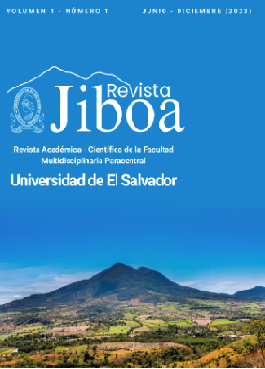Algunos efectos de la implementación de la modalidad de educación semipresencial en la FMP-UES para la pandemia COVID-19
DOI:
https://doi.org/10.5281/zenodo.10045692Palabras clave:
Educación semipresencial, brecha digital, impacto en el aprendizaje, acceso a la tecnologíaResumen
Durante el primer ciclo académico de 2022 se realizó un estudio para conocer la opinión de los estudiantes sobre los efectos de la modalidad semipresencial en las actividades académicas desarrolladas en la Facultad Multidisciplinaria Paracentral de laUniversidad de El Salvador. Fue a partir de este ciclo cuando se comenzaron a incluir actividades presenciales, porque desde el inicio de la pandemia hasta el segundo ciclo en 2021 las actividades eran totalmente en línea. El estudio se realizó utilizando un enfoque cuantitativo y se organizó en diferentes fases, incluida la planificación, la ejecución y el análisis de datos. Participaron completando la encuesta 500 estudiantes de las 12 carreras de pregrado que ofrece la Facultad, esta cantidad corresponde a la muestra probabilística según la totalidad de inscritos en ese ciclo. Como parte de los resultados se evidencia que existe una serie de limitaciones en el acceso a la formación profesional en la facultad, siendo el principal problema la conectividad a internet, ya que un 66.2% expresó perder la señal cuando llueve o peor aún, más de un tercio de los estudiantes tienen dificultades de cobertura lo que les impide asistir en su totalidad a las clases. El dispositivo que la mayoría de los estudiantes utilizó para conectarse a las clases fue el celular (93.8%) y tomando en cuenta el tamaño de las pantallas de estos dispositivos no siempre se garantiza la correcta visualización de los contenidos. A pesar de algunas situaciones no tan favorables, la opinión sobre los aprendizajes obtenidos bajo la modalidad semipresencial es positiva (76%).
Referencias
Acuña, J. G. (2008). Estudiantes universitarios: Entre la brecha digital y el aprendizaje. Apertura, 8(8), 21-33.
Arango, M. I. D. (2017). Determinar factores de riesgo psicosocial en docentes de bachillerato colegio Santa Ana.
Arango, M. I. D. (2017). Determinar factores de riesgo psicosocial en docentes de bachillerato colegio Santa Ana.
Cabezas-Heredia, E., Herrera-Chávez, R., Ricaurte-Ortiz, P., & Novillo Yahuarshungo, C. (2021). Depresión, Ansiedad, estrés en estudiantes y docentes: Análisis a partir del Covid 19. Revista Venezolana de Gerencia, 26(94), 603-622.
Campos, L. E. (2021). La efectividad del aula invertida en línea como estrategia didáctica a distancia para la educación superior, durante la cuarentena por COVID19: Un estudio de caso. Revista panamericana de comunicación, 3(1), 102-115.
Casero Béjar, M. de la, & Sánchez Vera, M. del M. (2022). Cambio de modalidad presencial a virtual durante el confinamiento por Covid-19: Percepciones del alumnado universitario: Change from Face-to-Face to Virtual Mode during Confinement due to Covid-19: Perceptions of University Students. RIED: Revista Iberoamericana de Educación a Distancia, 25(1), 243-260. https://doi.org/10.5944/ried.25.1.30623
Bernal-Meneses, L., Gabelas-Barroso, J. A., & Marta-Lazo, C. (2019). Relation, information and communication technologies (RICTs) as a tool for social integration. Interface - Comunicação, Saúde, Educação, 23, e180149.
De Castro De Castro, A. E., Borjas, M., Ricardo, C., Herrera, M., & Vergara, E. (2022). Recursos educativos digitales para la educación infantil(REDEI). Zona Próxima, 20, 1-21. https://doi.org/10.14482/zp.20.5888
Decuypere, M., Grimaldi, E., & Landri, P. (2021). Introduction: Critical studies of digital education platforms. Critical Studies in Education, 62(1), 1-16. https://doi.org/10.1080/17508487.2020.1866050
Hoffman, D., & Novak, T. (2001). The Evolution of the Digital Divide: Examining the Relationship of Race to Internet Access and Usage Over Time.
Ortiz, E. I., Herrera, E., & Torre, A. D. L. (2020). Coronavirus (COVID 19) Infection in Pregnancy. Colombia Médica, 51(2). https://www.redalyc.org/journal/283/28364445003/
Palma, M. G. (2019). Educación y exclusión digital: Los falsos nativos digitales. Revista de Estudios Socioeducativos. ReSed, 7, Article 7.
Pinto-Santos, A. R., George-Reyes, C. E., & Cortés-Peña, O. F. (2022). Brecha digital en la formación inicial docente: Desafíos en los ambientes de aprendizaje durante la pandemia COVID-19 en La Guajira (Colombia): Digital gap in initial teacher training: challenges in learning environments during the COVID-19 pandemic in La Guajira (Colombia). Formación Universitaria, 15(5), 49-60. https://doi.org/10.4067/S0718-5006202200050004
Descargas
Publicado
Número
Sección
Licencia
Derechos de autor 2023 https://creativecommons.org/licenses/by/4.0/

Esta obra está bajo una licencia internacional Creative Commons Atribución-NoComercial-CompartirIgual 4.0.







